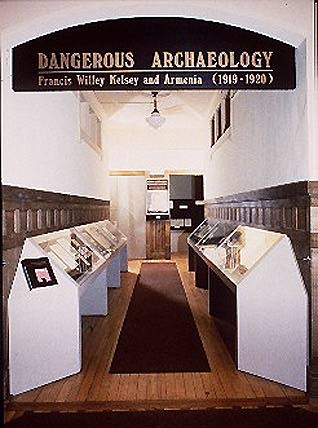and Armenia (1919-1920)

Francis Willey Kelsey
and Armenia
(1919-1920)

The enormity of this particular corpus of information is impossible to document fully in the small format of this exhibition. Hundreds of photographs, letters, telegrams, diaries, and other archival pieces furnish tangible testimonies to the unfolding drama of one American archaeologist's expedition to the Near East in the short period of fragile peace immediately following the Great War.
There are many significant aspects of this drama -- its modern historical setting bounded by violent confrontations between ethnically, religiously and politically defined groups, its fluctuating national and international borders. Most important for our present purpose, however, are the historical ramifications. Although most of these documents and objects are artifacts of recent manufacture, they are the basic materials from which history is written. They are presented here as such.
The central premise of the exhibition is this: past and present are inextricably intermingled even in the thoughts of those who write the histories. Archaeologists, like the University of Michigan's F.W. Kelsey, re-construct history from the surviving bits and pieces of daily lives. Archaeologists' historical perspectives are determined by their understanding of the present. This exhibition presents a glimpse into that complex process of writing history by showing, first, something of archaeologists and their methods, and second, the archaeologist Kelsey's version of one moment from the recent past and how it was shaped by Kelsey's own involvement.
Within history, literature, and archaeology in particular, a number of recently published studies are concerned with how present preoccupations condition understanding of the past. The significance of such interaction between the past and the present is of increasing concern to contemporary scholars who trace the history of disciplines to distinguish the roads taken from those not taken, and to question the validity of previously unassailable truths. Museum presentations increasingly, on the one hand, explicate the nostalgia surrounding a given monument or culture and, on the other hand, chart the history of collecting, of art history, and of archaeology.
This exhibition explores the interlocking of past and present by focusing on two inter-related themes reflected in the two parts of the exhibition's title. Dangerous Archaeology describes an important moment in the development of the discipline by focusing on the overlapping of the last generation of scholar- explorers with the first generation of more scientifically-minded archaeologists. Indeed, the characteristics of these successive generations are sometimes discernible in one individual. The original interests of both generations lay in uncovering the roots of their own cultures. The broad description presented here includes not only the words of these archaeologists, particularly those working in the Near East during the years between the World Wars, but also the opinions of outsiders about them, their discoveries, and their opinions.
Francis Willey Kelsey and Armenia (1919-1920) delves into the special case of an extended Near Eastern expedition undertaken by the archaeologist who was so instrumental in forming the core of the Kelsey Museum's numerous holdings and in developing the study of archaeology at the University of Michigan. The focus on Kelsey in this section of the exhibition displays telling characteristics of the new breed of American archaeologists. Significantly, the expedition presented here had many purposes: scouting sites or future excavations, collecting ancient and mediaeval objects, compiling ethnological data, conducting missionary work, and carrying out various diplomatic projects. As is indicated in the exhibition's title, the focus of many of these activities was on a part of the Near East once recognized as the land of Cilician Armenia.
Thelma K. Thomas
Assistant Curator
1992
* * *
The checklist (Appendix 1) reproduces elements of the exhibition not found in the pages of the exhibition catalogue. All of the text of the catalog except the introduction is included in the exhibition. Chapters of the catalog correspond to cases in the exhibition. For the sake of clarity some sections of the exhibition have been excerpted from the text of the catalog for inclusion in the checklist. Additional text panels, many concerning the discipline of archaeology, as well as brief identification labels for each object displayed, are reproduced.